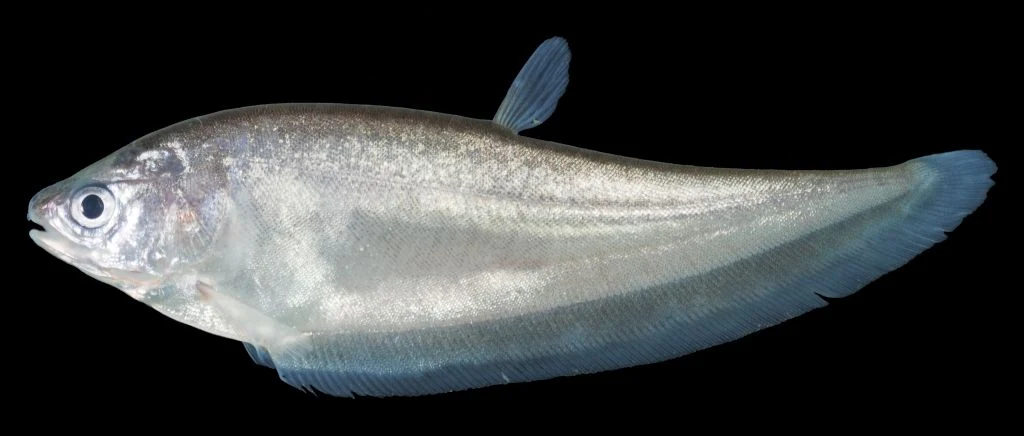Fish | Notopterus spp. (Pari) | fish | fishing | angler fish | goldfish |
Notopterus spp. (Pari)
This fish belongs to family Notopteridae. The fish of this
family predominantly inhabit tropical freshwaters and brackish water. These
fish have diverse body form and size. Genus Notopterus is represented by two
species namely, N. notopterus and N. chitala in Pakistan. These fishes are
often seen at the surface, splashing and exposing their silvery flanks. N.
chitala attains a maximum length up to 122cm, whereas N. notopterus is a small
fish and attains a maximum length of 60cm. Presence of 15-silvery bars on back
and a hump in N. chitala can easily distinguish it from N. notopterus
Geographical Distribution:
These fishes inhabit particularly
larger rivers and flood plains. These are also found in stagnant backwaters.
Three genera are found in tropical Africa and East Asia, whereas one namely
Notopterus in India and Pakistan, Bangladesh, Burma, Thailand, Malaya and
Indonesia.
 |
Fish | Notopterus spp. (Pari) | fish | fishing | angler fish | goldfish | |
Distinguishing Characters:
A very long anal fin which begins just behind
the head and extends along the under surface of the body to tip of the caudal
fin. Caudal fin confluent with anal fin. On the dorsal side in the center is a
small slender dorsal fin from which the fish derives the name ― Feather-back.‖
Pelvic fins rudimentary, scales small, lateral line complete. These fishes are
dull on the back and silvery on the sides.
Feeding:
It feeds on live foods, aquatic insects,
snails and surface swimming fishes. It mostly feeds during night time,
therefore, it is also called nocturnal predator.
Breeding:
During the rainy season, the sexually mature
specimens migrate to flooded swamps. The eggs are laid on aquatic plants,
fallen trees and branches in the water. They are guarded by the male who fans
the spawn to keep them aerated. After production of fry they return to the main
streams along with their fry.
Prospects in Aquaculture:
Although it is regarded as a good game fish
yet due to its carnivorous habits, slow growth and presence of a large number
of intra-muscular bones in its flesh, it is not used as a culturable species of
fish for aquaculture practices.
Bagarius bagarius (Fauji Khagga)
This fish belongs to family Sisoridal. It is an exclusively
Asian family of bottom dwelling catfishes. Most with more or less thickened
leathery skins. The genus Bagarius of this family has head and body covered by
heavily keratinised skin superficially differentiated into un-calciferous
plaques or tubercles. Bagarius bagarius is the well known member of this genus
found in Pakistan. It is locally called "Fauji Khagga" or
"Gonch".
Geographical distribution:
These fishes are mainly inhabitant of rapid
and rocky pools. Bagarius bagarius is found in Punjab, Sind, Khyberpakhtunkhwa in
Pakistan and other Asian countries including India, Nepal, Bangladesh, Burma,
Thailand, Malaysia and Indonesia.
Distinguishing characters:
The body of this fish is rather elongate, head
depressed. Mouth is inferior and crescentic, barbels four pairs. Dorsal fin
inserted near to adipose fin than to snout tip. Pelvic fins inserted anterior
to a ventral line through base of last dorsal fin ray. Abdominal vertebrae 17
to 20. Body is green or olivaceous to rich green tan or brown, with darkly
pigmented bands or blotches. Caudal fin light yellowish grey; paired fins with
black spots.
Feeding:
B. bagarius is a strongly
carnivorous and voracious fish. It preys on a variety of fishes and other live
food. It also feeds on carrion.
Breeding:
its breeding season starts prior to the
commencement of the monsoon rains.
Prospectus in aquaculture:
This is one of the largest Asian catfish and
so far the largest member of sisoridae. It grows to 120 kg in weight and 2 m in
length. The flesh is not much relished being very stiff and fibrous. This fish
is also called freshwater shark because of its strong voracious and carnivorous
feeding habits. Due to these demerits it has not been included in the list of
culturable species of fishes.














Post a Comment